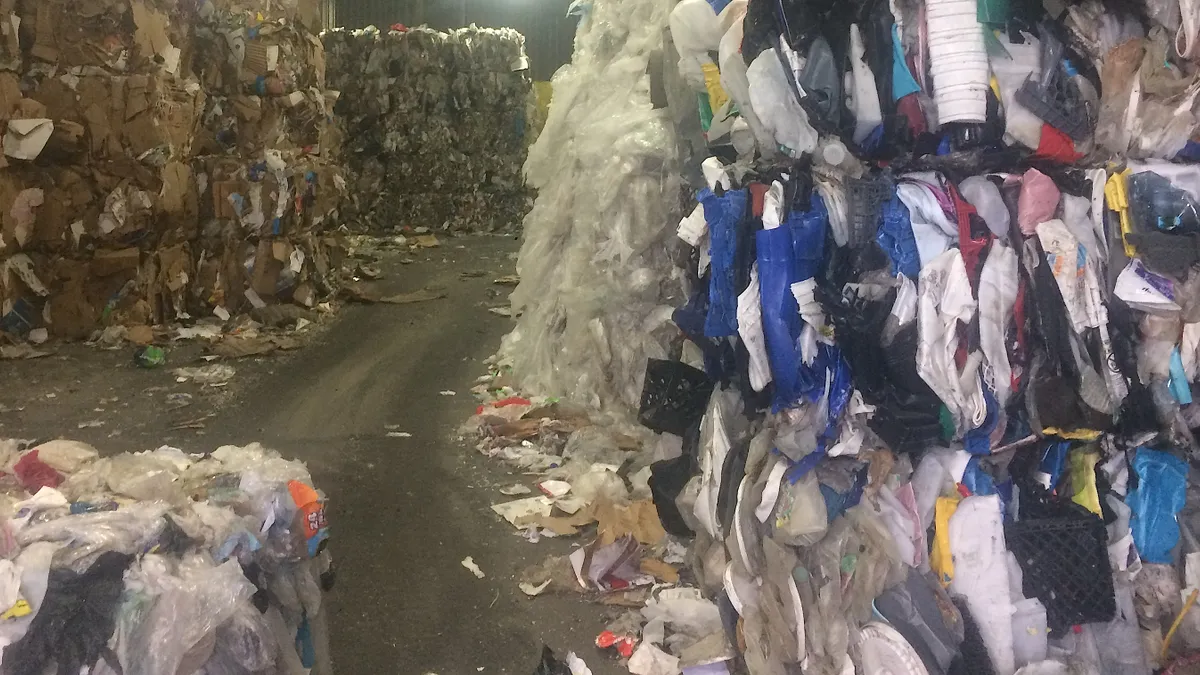Dive Brief:
- The United States saw an 8.6% increase in export value between 2016 and 2017, with a total value of $17.9 million of exported scrap commodities, according to an analysis by the Institute of Scrap Recycling Industries (ISRI). Demand for ferrous and nonferrous metal scrap offset a weaker market demand for non-metallic scrap, creating an overall boost.
- While the overall scrap export market may have grown in 2017, exports of plastic and paper to China shrank significantly. The U.S. exported 13.2 million metric tons of recovered paper and fiber to China in 2016, but just 10.8 million metric tons in 2017, an 18% decrease in tonnage that resulted in a 10% decrease in dollar value. Fiber markets in other nations saw some growth in that same time period.
- Plastic exports to China and Hong Kong from the U.S. hurt, too. In 2016, the U.S. exported 775,500 tons of plastic to China, down to 557,880 metric tons in 2017, a 28% decrease in metric tonnage resulting in a 32% decrease in dollar value. Exports to Hong Kong from the U.S. decreased 43% by metric tonnage and 38% by dollar value.
U.S. exports of recovered paper and fiber in metric tons show loss in China, gain in other markets
| Country | 2016 | 2017 | % Change |
|---|---|---|---|
|
China |
13,210,375 | 10,887,269 | -18 |
| India | 1,561,837 | 1,930,720 | 24 |
| Vietnam | 120,673 | 397,162 | 229 |
| Canada | 674,788 | 7 343,210 | 9 |
| Indonesia | 381,358 | 440,585 | 16 |
Dive Insight:
Paper exports from the U.S. remain consistent overall, with only significant drops in China and Korea and minimal drop in Thailand (by volume, not value), with gains elsewhere around the world. Despite market disruption and price drops, the dollar value of U.S. recovered paper and fiber exports was 1.4% higher in 2017 year over year, thanks to growing sales in countries including Canada, Vietnam and India.
The real space to watch, of course, is the market for plastic. China, Hong Kong, Canada and Indonesia all imported less plastic scrap from the U.S. in 2017 than in 2016.
U.S. exports plastic scrap in metric tons dropped dramatically in Canada and the Pacific
| Country | 2016 | 2017 | % Change |
|---|---|---|---|
| China | 775,539 | 557,880 | -28 |
| Hong Kong | 653,726 | 373,216 | -43 |
| Canada | 165,024 | 135,597 | -18 |
| Indonesia | 34,407 | 28,729 | -17 |
The drop in Chinese imports of U.S. plastic scrap led to the lowest volume of U.S. plastic scrap export since 2008, according to ISRI.
And, while the combined market loss is great, data from ISRI reveals new markets have developed in Southeast Asia between 2016-2017.
U.S. exports of plastic scrap in metric tons show gains in some markets in light of Chinese disruption
| Country | 2016 | 2017 | % Change |
|---|---|---|---|
| India | 91,913 | 123,165 | 34 |
| Vietnam | 66,747 | 137,044 | 105 |
| Malaysia | 38,790 | 119,098 | 207 |
| Mexico | 32,005 | 46,376 | 45 |
| Thailand | 6,541 | 32,680 | 400 |
The growth of new markets outside of China is not, of course, a magic bullet. Recycling systems across the entire U.S. are facing serious disruption, with MRFs becoming backlogged and states issuing disposal waivers so processors can landfill recycled material for which there is no buyer. Some cities, such as Boise, ID, are considering severe changes to their recycling programs, limiting certain materials or charging consumers more for recycling service.
And it is likely there is more disruption to come. The ban on certain materials is in effect, and China has also been limiting the number of import licenses it issues, but the final 0.5% contamination standard has yet to go into full enactment. As that happens, it is likely markets for scrap material will continue to tighten.
Domestically, one of the best methods for protecting municipal recycling operations may be to focus on reducing consumer contamination. The cleaner each collection pick-up is, the cleaner material will be when it reaches the MRF, leading to higher-quality bales.
Industry groups have been singing this song for some time, but recently the Solid Waste Association of North America (SWANA) announced it was launching a task force on recycling to help local governments and other stakeholders boost domestic recycling markets.
The full effects of China's shifting import policies — which may spread to other countries — are yet to be seen, but one thing is certain: It is not going to be an easy ride for the U.S. recycling industry. As municipalities and haulers scramble to decide what to do to handle material, customers and residents could face price hikes or canceled services.














